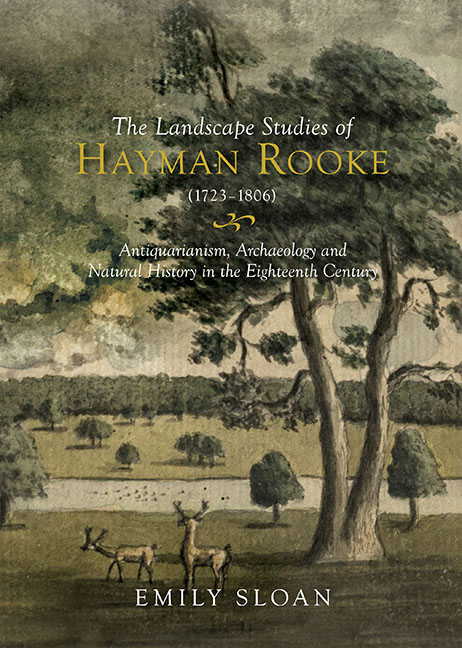 The Landscape Studies of Hayman Rooke (1723–1806)
The Landscape Studies of Hayman Rooke (1723–1806) Book contents
- Frontmatter
- Contents
- List of Illustrations
- Acknowledgements
- List of Abbreviations
- Introduction
- chapter 1 Rooke and His World
- chapter 2 Rooke and the Natural World
- chapter 3 Rooke and Ancient Britain
- chapter 4 Rooke and Roman Britain
- Conclusion Rooke and his Landscape Studies
- Appendix 1 List of Rooke's Publications
- Appendix 2 Reconstruction of Rooke's Diary
- Notes to the Text
- Bibliography
- Index
- Frontmatter
- Contents
- List of Illustrations
- Acknowledgements
- List of Abbreviations
- Introduction
- chapter 1 Rooke and His World
- chapter 2 Rooke and the Natural World
- chapter 3 Rooke and Ancient Britain
- chapter 4 Rooke and Roman Britain
- Conclusion Rooke and his Landscape Studies
- Appendix 1 List of Rooke's Publications
- Appendix 2 Reconstruction of Rooke's Diary
- Notes to the Text
- Bibliography
- Index
Summary
Major Hayman Rooke was an eighteenth-century soldier, antiquarian, meteorologist, amateur artist and, by all accounts, an upright and affable character. He was also extraordinarily busy and spent much of his time out and about visiting friends and travelling, exploring traces of the past in the landscape, scrambling up rock faces to look at caves, or riding around estate plantations examining trees. Rooke recorded his many expeditions in more than 400 sketches and published his findings in a range of outlets including journals, books and pamphlets. Major Rooke's work on antiquarianism and natural history offers an opportunity to examine the interpretation of landscape during the eighteenth century; that is, some of the ways in which antiquarian study contributed to a sense of place and to broader political and social experiences and interpretations of landscape. This includes how landscapes were explained and understood – how antiquarian and natural historical practice functioned as a form of engagement with place. Locality was, of course, significant to antiquarian and natural history studies, given the place-specificity of their subjects; but this place-specific information was shared as well as contributing to a wider project of the discovery of a national landscape, meaning that eighteenthcentury communication networks played a significant role in the process of knowledge formation.
These questions can be approached through a study of both the theoretical and physical spaces of the eighteenth century, especially those in which Rooke was actively engaged. These can be seen as falling into three wide-ranging and interlinked spaces of investigation: regional study, spaces of exchange and spaces of practice. Regional study refers to the spatial or territorial loyalties of the antiquarian to a particular area, the role and influence of the county history as a mode of spatial definition and the relationship between antiquarianism, regional study and chorography – the impact of regional study on ideas of politics and identity, a sense of belonging in place. These were of course greatly affected by the personal mobility of antiquarians and natural historians like Rooke, and Rooke's own travels are discussed. The spaces of exchange – the networks of correspondence, publications and meetings through which ideas and artefacts travelled, and which contributed to the creation and reinforcement of antiquarian reputations – make it possible to trace the ways in which knowledge was created and negotiated.
- Type
- Chapter
- Information
- The Landscape Studies of Hayman Rooke (1723–1806)Antiquarianism, Archaeology and Natural History in the Eighteenth Century, pp. 1 - 8Publisher: Boydell & BrewerPrint publication year: 2019
